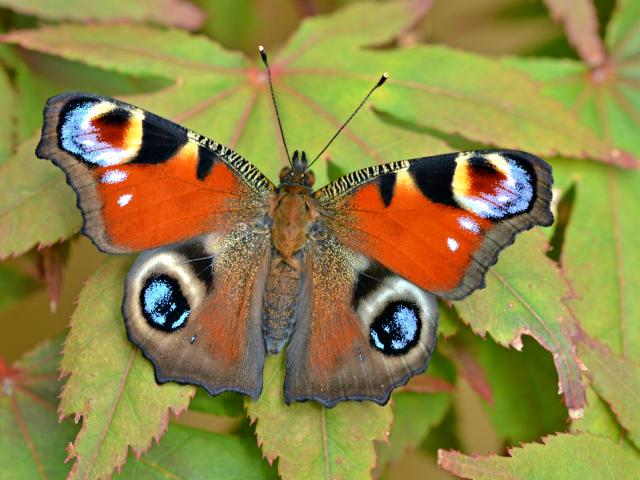‘What is the difference between butterflies and moths?’ is one of the questions I am most frequently asked. Unfortunately, there isn’t a straightforward answer – at least not one that most people find acceptable.
I usually start by dispelling some of the common misconceptions. It’s not about colour, hairiness or time of day. There are brightly coloured moths and there are dull, brown butterflies. Mostly butterflies have a good covering of ‘hair’ on their thorax, where their big flight muscles are located, although none are as hairy as something like the December Moth. And, of course, there are many more day-active moth species in the UK than butterflies (plus a few butterflies, such as the Red Admiral, do fly at night when on migration).

The next step is to point out the useful rules of thumb. Butterflies usually have ‘club-shaped’ antennae while most moths have feathery or tapering ones. No UK butterflies have feathery antennae, but some butterflies and moths have rather similar shaped antennae (e.g. Dingy Skipper and Six-spot Burnet). Butterflies normally fold their wings vertically over their backs while most moths hold their wings horizontally when at rest (although quite a few Geometrids, such as the Thorns, hold them vertically or at an angle). So, while useful as a guide, there are plenty of exceptions to these ‘rules’.
The real answer to the question and the answer that people find so troubling is that there isn’t really much of a difference at all. The fact that in English at least, society has different words and, indeed, very different attitudes to them is largely a cultural concept rather than a scientific one.
All moths and butterflies belong to the group Lepidoptera, which is one of the great, mega-diverse insect Orders on the planet, comprising some 165,000 species worldwide of which only c.18,000 are butterflies. A similar situation exists in Britain where we have only about 60 butterfly species but over 2,500 recorded moths. So, clearly if we want to apply a common, English name to the Order Lepidoptera ‘moths’ is much more appropriate than ‘butterflies’.

Even more perplexing is the state of higher taxonomy among butterflies and moths. Generally speaking, the inter-relationships between species are very well known for the butterflies and moths that occur in the UK. We know which ones are closely related to each other i.e. in the same genus, such as the Red Admiral and Painted Lady (both in the genus Vanessa) or all the Carpet moths (all in the family Geometridae). These inter-relationships tend to feel familiar and stable, although changes do take place from time to time.
It came as a bit of a shock to me a couple of years ago to learn that the higher-level relationships between butterflies and moths, e.g. how the families and higher-level groups are related to each other, is much, much less clear. It seems that the evolutionary course charted by the Lepidoptera has been one of a long period with a very low rate at which new species evolved and then a short (in geological terms) period of very rapid diversification and speciation, probably in parallel with the evolution of flowering plants. This pattern makes it very hard to unravel inter-relationships nowadays based on the physical and molecular characteristics of modern moths and butterflies.

Scientists have been trying hard though and several recent publications have generated some surprising conclusions. First, among the butterflies it had long been thought that the Skippers were a group apart from all the other butterfly families. However, the latest analyses strongly suggest that the Skippers, and a small group of curious South American moth-like butterflies, the Hedylids, are together closely related to the rest of the butterflies (the whites, blue and browns). But extraordinarily, the Papillionids (Swallowtails, Apollos and Festoons), which were always considered to be true butterflies, appear to more distantly related – a sister group to all the other butterflies.
The second, even greater surprise, concerned where the butterfly families sit among the different families of moths. Butterflies have always been placed as a group within the Macrolepidoptera .However, it now appears that the concept of the Macrolepidoptera as currently defined (i.e. macro-moths plus butterflies) is not valid scientifically. Instead, the evidence suggests that Pyraloids (Pyralids and Crambids), normally considered micros, are more closely related to the main macro-moths families (e.g. Noctuids, Geometrids, hawk-moths etc.) than butterflies are.

So, if they are not ‘macros’, butterflies must sit somewhere among the micro-moth groups. At this point the picture becomes very unclear. Difference analyses yield different patterns, placing the butterflies close to micro-moth groups such as the Gelechiids as well as “honorary macros” such as the clearwings, Cossiids (Leopard and Goat moths) and burnet moths. If you really want to get into the detail, have a look at this research paper.
No doubt there will be further discoveries and some of this new research may be turned on its head. However, it seems unlikely that butterflies are closely related to the true macro-moth groups, but instead have their ancestors among the micros.
Richard Fox
Surveys Manager
Follow on Twitter: @RichardFoxBC
With thanks to Dr Malcolm Scoble, Natural History Museum


